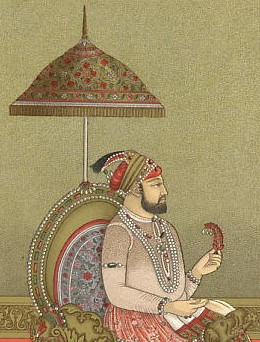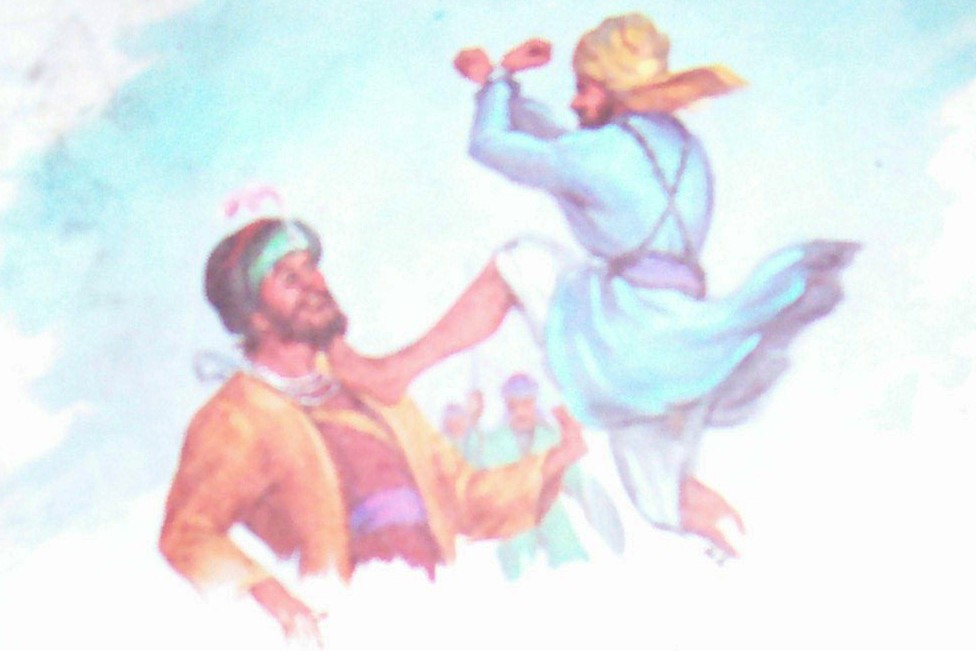Farrukhsiyar
Abu'l Muzaffar Muin ud-din Muhammad Shah Farrukh-siyar Alim Akbar Sani Wala Shan Padshah-i-bahr-u-bar [Shahid-i-Mazlum] (or Farrukhsiyar) (August 20, 1685 - April 19, 1719) was the Mughal emperor of India between 1713 and 1719. He was the second son of 'Azim al-Shan the third son of Bahadur Shah I. Born at Aurangabad in the Deccan on 11 September 1683, he in his tenth year accompanied his father to Agra, and in 1697 to Bengal, when that province was added to his charge. In 1707, when 'Azim al-Shan was summoned to the court by Aurangzeb, Farrukh-Siyar was nominated his father's deputy there, which post he held until his recall by 'Azim al-Shan in 1711.
When Bahadur Shah died at Lahore on 27 February 1712, Farrukh-Siyar was at Patna, having tarried there since the previous rainy season. Following the defeat and death of his father in the contest at Lahore, Farrukh-Siyar proclaimed himself emperor at Patna on 6 March 1712. He marched on Delhi, defeating Jahandar Shah, who had succeeded Bahadur Shah, on 10 January 1713, after a hardfought battle at Samugarh near Agra.
Reign of Terror
After his accession to the throne of Delhi, Farrukh-Siyar launched the sternest proceedings against the Sikhs, who had under Banda Singh Bahadur freed much of the Punjab from mughal rule. He deputed his best military generals against them. 'Abd us-Samad Khan was appointed governor of Lahore and was entrusted with the task of quelling Sikh insurrection. According to Akhbar-i-Darbdr Mu'alla, high ranking military generals such as Bakhshi ul-Mulk, Muhammad Khan Bahadur, Ghazi ud-Din Khan Bahadur, Mahabat Khan Bahadur and Hamid ud-Din Khan Bahadur moved against the Sikhs at the head of their forces.
Soon severed heads of the Sikhs were frequently sent, by the cartload, to please the emperor. The Sikhs' main column under Banda Singh Bahadur was subjected to a protracted siege at the village of Gurdas Nangal, about 6 km from Gurdaspur. For eight long months, the garrison resisted the siege under gruesome conditions. Out of food, water, and ammunition the half dead skeletal survivors were siezed when the Mughal armies, on December 7, 1715, broke through the walls capturing Banda Bahadur and his starved companions.
After being paraded in the streets of Lahore, they were taken to Delhi where they arrived on 27 February 1716. Besides 740 prisoners in heavy chains, the cavalcade included seven hundred cartloads of the heads of Sikhs with another 2,000 heads carried impaled atop pikes. By Farrukh-Siyar's order, Banda Singh and some two dozen leading Sikhs were imprisoned in the Fort, while the remaining 694 were made over to the kotwal, Sarbarah Khan, where they were executed in the Kotwali Chabutra at the rate of a hundred a day. Banda Singh Bahadur and his remaining companions were taken to the tomb of Khwaja Qutb ud-Din Bakhtiyar Kaki, near the Qutb Minar. There he was offered the choice between Islam and death. Upon his refusal to renounce his faith, his four year old son, Ajai Singh, was hacked to pieces before his eyes. Banda Singh himself was subjected to the harshest torments. His eyes were pulled out and hands and feet chopped off. His flesh was torn with redhot pincers and finally his body was cut up limb by limb. This happened on 9 June 1716.
According to George Forster in his, 'A Journey from Bengal to England' , an edict was issued by Farrukh-Siyar after the execution of Banda Singh directing that:
- "…every Sicque falling into the hands of his officers should, on a refusal of embracing the Mahometan faith, be put to the sword. A valuable reward was also given by the emperor for the head of every Sicque; and such was the keen spirit that animated the persecution, such the success of the exertions, that the name of a Sicque no longer existed in the Mughul dominion. Those who still adhered to the tenets of Nanock, either fled into the mountains at the head of the Punjab, or cut off their hair, and exteriorly renounced the profession of their religion."
Blinding and Death
After many failed plots against the Saiyid brothers, his wazir and military commander, the real power holders of the kingdom, Farrukh-Siyar was blinded, deposed and killed by the Saiyids' men who used needles to put out the eyes of the emperor on 28 February 1819 (a blinded ruler lost all right to rule) then on the night of April 27th Farrukh-Siyar was choked to death. The Saiyid brothers installed his first-cousin, Rafi Ul-Darjat on the throne.


